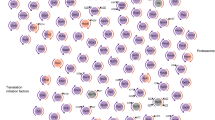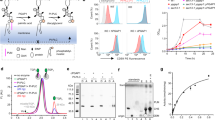Abstract
Nucleocytoplasmic glycosylation of proteins with O-linked N-acetylglucosamine residues (O-GlcNAc) is recognized as a conserved post-translational modification found in all metazoans. O-GlcNAc has been proposed to regulate diverse cellular processes. Impaired cellular O-GlcNAcylation has been found to lead to decreases in the levels of various proteins, which is one mechanism by which O-GlcNAc seems to exert its varied physiological effects. Here we show that O-GlcNAcylation also occurs cotranslationally. This process protects nascent polypeptide chains from premature degradation by decreasing cotranslational ubiquitylation. Given that hundreds of proteins are O-GlcNAcylated within cells, our findings suggest that cotranslational O-GlcNAcylation may be a phenomenon regulating proteostasis of an array of nucleocytoplasmic proteins. These findings set the stage to assess whether O-GlcNAcylation has a role in protein quality control in a manner that bears similarity with the role played by N-glycosylation within the secretory pathway.
This is a preview of subscription content, access via your institution
Access options
Subscribe to this journal
Receive 12 print issues and online access
$259.00 per year
only $21.58 per issue
Buy this article
- Purchase on Springer Link
- Instant access to full article PDF
Prices may be subject to local taxes which are calculated during checkout





Similar content being viewed by others
References
Torres, C.R. & Hart, G.W. Topography and polypeptide distribution of terminal N-acetylglucosamine residues on the surfaces of intact lymphocytes. Evidence for O-linked GlcNAc. J. Biol. Chem. 259, 3308–3317 (1984).
Gambetta, M.C., Oktaba, K. & Muller, J. Essential role of the glycosyltransferase sxc/Ogt in polycomb repression. Science 325, 93–96 (2009).
Hanover, J.A., Krause, M.W. & Love, D.C. Bittersweet memories: linking metabolism to epigenetics through O-GlcNAcylation. Nat. Rev. Mol. Cell Biol. 13, 312–321 (2012).
Sinclair, D.A. et al. Drosophila O-GlcNAc transferase (OGT) is encoded by the Polycomb group (PcG) gene, super sex combs (sxc). Proc. Natl. Acad. Sci. USA 106, 13427–13432 (2009).
Ohn, T., Kedersha, N., Hickman, T., Tisdale, S. & Anderson, P. A functional RNAi screen links O-GlcNAc modification of ribosomal proteins to stress granule and processing body assembly. Nat. Cell Biol. 10, 1224–1231 (2008).
Zachara, N.E. et al. Dynamic O-GlcNAc modification of nucleocytoplasmic proteins in response to stress. A survival response of mammalian cells. J. Biol. Chem. 279, 30133–30142 (2004).
Kim, E.Y. et al. A role for O-GlcNAcylation in setting circadian clock speed. Genes Dev. 26, 490–502 (2012).
Li, M.D. et al. O-GlcNAc signaling entrains the circadian clock by inhibiting BMAL1/CLOCK ubiquitination. Cell Metab. 17, 303–310 (2013).
Olivier-Van Stichelen, S. et al. O-GlcNAcylation stabilizes β-catenin through direct competition with phosphorylation at threonine 41. FASEB J. 28, 3325–3338 (2014).
Yang, W.H. et al. Modification of p53 with O-linked N-acetylglucosamine regulates p53 activity and stability. Nat. Cell Biol. 8, 1074–1083 (2006).
Park, S.Y. et al. Snail1 is stabilized by O-GlcNAc modification in hyperglycaemic condition. EMBO J. 29, 3787–3796 (2010).
Ruan, H.B., Nie, Y. & Yang, X. Regulation of protein degradation by O-GlcNAcylation: crosstalk with ubiquitination. Mol. Cell. Proteomics 12, 3489–3497 (2013).
Haltiwanger, R.S., Holt, G.D. & Hart, G.W. Enzymatic addition of O-GlcNAc to nuclear and cytoplasmic proteins. Identification of a uridine diphospho-N-acetylglucosamine:peptide β-N-acetylglucosaminyltransferase. J. Biol. Chem. 265, 2563–2568 (1990).
Lubas, W.A., Frank, D.W., Krause, M. & Hanover, J.A. O-Linked GlcNAc transferase is a conserved nucleocytoplasmic protein containing tetratricopeptide repeats. J. Biol. Chem. 272, 9316–9324 (1997).
Gao, Y., Wells, L., Comer, F.I., Parker, G.J. & Hart, G.W. Dynamic O-glycosylation of nuclear and cytosolic proteins: cloning and characterization of a neutral, cytosolic β-N-acetylglucosaminidase from human brain. J. Biol. Chem. 276, 9838–9845 (2001).
Lazarus, M.B., Nam, Y., Jiang, J., Sliz, P. & Walker, S. Structure of human O-GlcNAc transferase and its complex with a peptide substrate. Nature 469, 564–567 (2011).
Zeidan, Q., Wang, Z., De Maio, A. & Hart, G.W. O-GlcNAc cycling enzymes associate with the translational machinery and modify core ribosomal proteins. Mol. Biol. Cell 21, 1922–1936 (2010).
Bengtson, M.H. & Joazeiro, C.A. Role of a ribosome-associated E3 ubiquitin ligase in protein quality control. Nature 467, 470–473 (2010).
Duttler, S., Pechmann, S. & Frydman, J. Principles of cotranslational ubiquitination and quality control at the ribosome. Mol. Cell 50, 379–393 (2013).
Wang, F., Durfee, L.A. & Huibregtse, J.M. A cotranslational ubiquitination pathway for quality control of misfolded proteins. Mol. Cell 50, 368–378 (2013).
Han, I. & Kudlow, J.E. Reduced O-glycosylation of Sp1 is associated with increased proteasome susceptibility. Mol. Cell. Biol. 17, 2550–2558 (1997).
Jackson, S.P. & Tjian, R. Purification and analysis of RNA polymerase II transcription factors by using wheat germ agglutinin affinity chromatography. Proc. Natl. Acad. Sci. USA 86, 1781–1785 (1989).
Roos, M.D., Su, K., Baker, J.R. & Kudlow, J.E. O-glycosylation of an Sp1-derived peptide blocks known Sp1 protein interactions. Mol. Cell. Biol. 17, 6472–6480 (1997).
Chung, S.S. et al. Activation of PPARγ negatively regulates O-GlcNAcylation of Sp1. Biochem. Biophys. Res. Commun. 372, 713–718 (2008).
Starr, C.M. & Hanover, J.A. Glycosylation of nuclear pore protein p62. Reticulocyte lysate catalyzes O-linked N-acetylglucosamine addition in vitro. J. Biol. Chem. 265, 6868–6873 (1990).
Vocadlo, D.J., Hang, H.C., Kim, E.J., Hanover, J.A. & Bertozzi, C.R. A chemical approach for identifying O-GlcNAc–modified proteins in cells. Proc. Natl. Acad. Sci. USA 100, 9116–9121 (2003).
Saxon, E. & Bertozzi, C.R. Cell surface engineering by a modified Staudinger reaction. Science 287, 2007–2010 (2000).
Gloster, T.M. et al. Hijacking a biosynthetic pathway yields a glycosyltransferase inhibitor within cells. Nat. Chem. Biol. 7, 174–181 (2011).
Yuzwa, S.A. et al. A potent mechanism-inspired O-GlcNAcase inhibitor that blocks phosphorylation of tau in vivo. Nat. Chem. Biol. 4, 483–490 (2008).
Zhang, F. et al. O-GlcNAc modification is an endogenous inhibitor of the proteasome. Cell 115, 715–725 (2003).
Davis, L.I. & Blobel, G. Nuclear pore complex contains a family of glycoproteins that includes p62: glycosylation through a previously unidentified cellular pathway. Proc. Natl. Acad. Sci. USA 84, 7552–7556 (1987).
Holt, G.D. et al. Nuclear pore complex glycoproteins contain cytoplasmically disposed O-linked N-acetylglucosamine. J. Cell Biol. 104, 1157–1164 (1987).
Rexach, J.E. et al. Quantification of O-glycosylation stoichiometry and dynamics using resolvable mass tags. Nat. Chem. Biol. 6, 645–651 (2010).
Boyce, M. et al. Metabolic cross-talk allows labeling of O-linked β-N-acetylglucosamine–modified proteins via the N-acetylgalactosamine salvage pathway. Proc. Natl. Acad. Sci. USA 108, 3141–3146 (2011).
Kazemi, Z., Chang, H., Haserodt, S., McKen, C. & Zachara, N.E. O-linked β-N-acetylglucosamine (O-GlcNAc) regulates stress-induced heat shock protein expression in a GSK-3β–dependent manner. J. Biol. Chem. 285, 39096–39107 (2010).
Guinez, C. et al. Protein ubiquitination is modulated by O-GlcNAc glycosylation. FASEB J. 22, 2901–2911 (2008).
Hardivillé, S., Hoedt, E., Mariller, C., Benaissa, M. & Pierce, A. O-GlcNAcylation/phosphorylation cycling at Ser10 controls both transcriptional activity and stability of Δ-lactoferrin. J. Biol. Chem. 285, 19205–19218 (2010).
Hart, G.W., Slawson, C., Ramirez-Correa, G. & Lagerlof, O. Cross talk between O-GlcNAcylation and phosphorylation: roles in signaling, transcription, and chronic disease. Annu. Rev. Biochem. 80, 825–858 (2011).
Forsythe, M.E. et al. Caenorhabditis elegans ortholog of a diabetes susceptibility locus: oga-1 (O-GlcNAcase) knockout impacts O-GlcNAc cycling, metabolism, and dauer. Proc. Natl. Acad. Sci. USA 103, 11952–11957 (2006).
Hanover, J.A. et al. A Caenorhabditis elegans model of insulin resistance: altered macronutrient storage and dauer formation in an OGT-1 knockout. Proc. Natl. Acad. Sci. USA 102, 11266–11271 (2005).
Hart, G.W., Housley, M.P. & Slawson, C. Cycling of O-linked β-N-acetylglucosamine on nucleocytoplasmic proteins. Nature 446, 1017–1022 (2007).
Radermacher, P.T. et al. O-GlcNAc reports ambient temperature and confers heat resistance on ectotherm development. Proc. Natl. Acad. Sci. USA 111, 5592–5597 (2014).
Helenius, A. & Aebi, M. Roles of N-linked glycans in the endoplasmic reticulum. Annu. Rev. Biochem. 73, 1019–1049 (2004).
Trombetta, E.S. & Parodi, A.J. Quality control and protein folding in the secretory pathway. Annu. Rev. Cell Dev. Biol. 19, 649–676 (2003).
Moremen, K.W. & Molinari, M. N-linked glycan recognition and processing: the molecular basis of endoplasmic reticulum quality control. Curr. Opin. Struct. Biol. 16, 592–599 (2006).
Hebert, D.N., Garman, S.C. & Molinari, M. The glycan code of the endoplasmic reticulum: asparagine-linked carbohydrates as protein maturation and quality-control tags. Trends Cell Biol. 15, 364–370 (2005).
Rothman, J.E. & Lodish, H.F. Synchronised transmembrane insertion and glycosylation of a nascent membrane protein. Nature 269, 775–780 (1977).
Chen, W., Helenius, J., Braakman, I. & Helenius, A. Cotranslational folding and calnexin binding during glycoprotein synthesis. Proc. Natl. Acad. Sci. USA 92, 6229–6233 (1995).
Bolt, G., Kristensen, C. & Steenstrup, T.D. Posttranslational N-glycosylation takes place during the normal processing of human coagulation factor VII. Glycobiology 15, 541–547 (2005).
Ruiz-Canada, C., Kelleher, D.J. & Gilmore, R. Cotranslational and posttranslational N-glycosylation of polypeptides by distinct mammalian OST isoforms. Cell 136, 272–283 (2009).
Hobden, A.N. & Cundliffe, E. The mode of action of α-sarcin and a novel assay of the puromycin reaction. Biochem. J. 170, 57–61 (1978).
Chen, C. & Okayama, H. High-efficiency transformation of mammalian cells by plasmid DNA. Mol. Cell. Biol. 7, 2745–2752 (1987).
Acknowledgements
Financial support through a Discovery Grant (grant number: RGPIN/298406-2010) the Natural Sciences and Engineering Research (NSERC) and the Canadian Institutes of Health Research (CIHR; grant number: MOP-123341) is gratefully acknowledged. Y.Z. thanks the CIHR for support through a postdoctoral fellowship. D.J.V. acknowledges the kind support of the Canada Research Chairs program for a Tier I Canada Research Chair in Chemical Glycobiology and NSERC for support as an E.W.R. Steacie Memorial Fellow. S.C. acknowledges the Government of Canada and the CIHR for postdoctoral fellowship support. R.E. acknowledges the Alzheimer Society of Canada and the Michael Smith Foundation for Health Research for postdoctoral fellowship support.
Author information
Authors and Affiliations
Contributions
Y.Z. and D.J.V. designed research; Y.Z. and T.-W.L. performed experiments; R.E. synthesized UDP-GlcNAz; W.F.Z. synthesized UDP-5SGlcNAc; S.C. synthesized the biotin-diazo-phosphine probe; Y.Z. and D.J.V. wrote the paper; all authors provided input into the manuscript.
Corresponding author
Ethics declarations
Competing interests
D.J.V. is a cofounder of Alectos Therapeutics, a company involved in the development of OGA modulators for the treatment of Alzheimer's disease. D.J.V. serves as CSO and chair of the Scientific Advisory Board of Alectos Therapeutics.
Supplementary information
Supplementary Text and Figures
Supplementary Results, Supplementary Figures 1–9 and Supplementary Note (PDF 3313 kb)
Rights and permissions
About this article
Cite this article
Zhu, Y., Liu, TW., Cecioni, S. et al. O-GlcNAc occurs cotranslationally to stabilize nascent polypeptide chains. Nat Chem Biol 11, 319–325 (2015). https://doi.org/10.1038/nchembio.1774
Received:
Accepted:
Published:
Issue Date:
DOI: https://doi.org/10.1038/nchembio.1774
This article is cited by
-
Discovery proteomics defines androgen-regulated glycoprotein networks in prostate cancer cells, as well as putative biomarkers of prostatic diseases
Scientific Reports (2021)
-
Target protein deglycosylation in living cells by a nanobody-fused split O-GlcNAcase
Nature Chemical Biology (2021)
-
An intellectual disability syndrome with single-nucleotide variants in O-GlcNAc transferase
European Journal of Human Genetics (2020)
-
O-GlcNAcylation of light chain serine 12 mediates rituximab production doubled by thiamet G
Bioprocess and Biosystems Engineering (2020)
-
New use for CETSA: monitoring innate immune receptor stability via post-translational modification by OGT
Journal of Bioenergetics and Biomembranes (2018)



